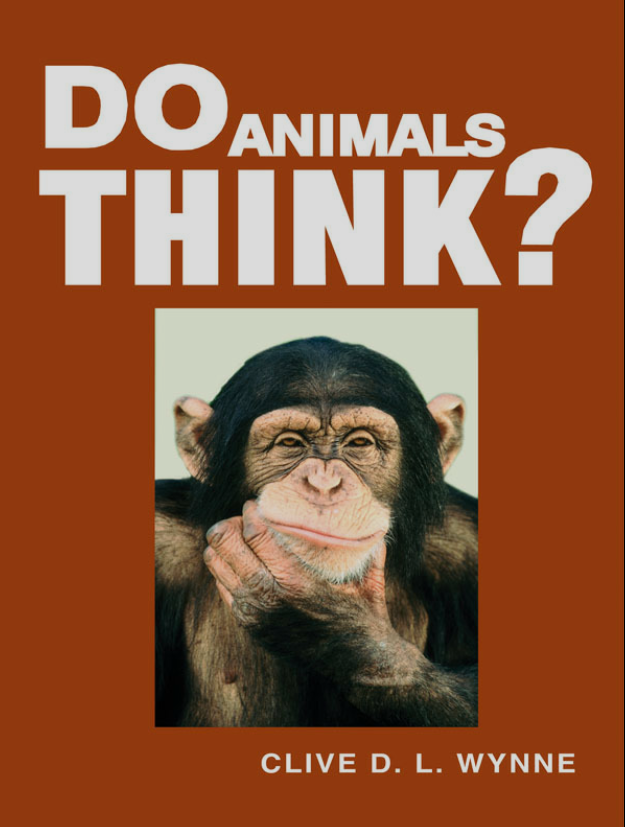Preview of things to come
_________________________
Can animals think?
THINKING (examples, features)
- Flexible, adaptive
- Can solve diverse and novel problems
- Figuring it out, deliberation
- Believing and desiring
- Insight, reasoning
- Often conscious
NOT THINKING (examples, features)
- Modules, not global workspace
- Fixed action patterns, instincts
- Trial and error
- Automatic information processing
- Can be complex and representational
- Often unconscious
Human mind: How much is thinking? How much is not thinking?
- Scientists divided--
- Skeptical: Celia Heyes, Peter Carruthers, Euan MacPhail, Clive Wynne
- Open: Frans DeWaal, Gordon Gallup, Kristin Andrews
- Eager: David DeGrazia, Mark Bekoff, Jane Goodall
- YOU are probably divided
- thinking apes, yes
- thinking spiders, no
_________________________
Experimental evidence
- Chimpanzees and crows: Inside the Animal Mind I 17:23 – 26
- Animal architects (birds, bees, wasps, beavers, spiders): are they on "automatic" or do they solve new problems as they arise? Japyassu and Laland -- they solve new problems as they arise
_________________________
A philosophical problem with attributing thought to animals
Background
Folk psychology--predicting and explaining behavior using belief-desire psychology
- Predicting. John desires some pizza and beliefs there's pizza in the fridge. What will he do?
- Explaining. Mary normally prefers pizza but chose the leftover pasta. Why? She believed they were both old and prefers old pasta to old pizza.
- Standing vs. occurrent
Propositional attitudes--beliefs and desires and other states are attributed with a that-clause. She believes THAT it is raining.
Most propositiional attributions are "opaque"--coreferential terms are not interchangeable inside the that-clause
- Lois believes that Superman is brave. (true)
- Lois believes that Clark Kent is brave. (false)
There is also a referentially transparent way of talking about beliefs.
- Lois believes, of Superman, that he is brave. (true)
- Lois believes, of Clark Kent, that he is brave. (true)
_________________________
Steven Stich, "Do Animals Have Beliefs?"
- Of course animals have beliefs and desires
- Of course animals don't have beliefs
Why think 2? Because there is no way to characterize the contents of their beliefs
Fido is digging in the backyard because he desires a meaty bone and believes that his human buried a bone in the backyard.
What is the right way out of this dilemma?
- Armstrong's way out. Transparent attributions.
- Fido believes there's a bone in the backyard ==>
- Fido believes, of the bone and the backyard, that IT is THERE.
- Stich: this trick won't always work.
- Fido believes that his food is disgusting.
- Concept psychology way out.
- Fido believes that the bone is in the backyard ==>
- Fido believes there is something with properties A, B, C, D, E, F...in something with properties G, H, I, J, K.
- Stich's way out. Animals have representations that are belief-like, but aren't beliefs.
_________________________
Next week: social animals, social skills
- Knowing social status of self and others
- Imitation
- Culture
- Mind reading
How do social animals comprehend their own social status in a hierarchical society?
- Do they think about social status? Do they have beliefs about it?
- More important: how do they represent the information they use?
Dorothy Cheney and Robert Seyfarth, Baboon Metaphysics (chapter assigned for next week)
Baboon Metaphysics: The Evolution of Social Mind from Penn Arts & Sciences on Vimeo.
What do baboons know?
- They know about the dominance relationships in the diagram below (from Andrews)
- They can reason: IF D12 defeats B4, then D13 has higher status than B5
How do they represent this knowledge?
- Seyfarth and Cheney: with the sentences of a language of thought
- Elisabeth Camp: better to say they have diagrams
- diagrams are domain specific
- this accounts for the fact that they can reason like this ONLY about dominance hierarchies




No comments:
Post a Comment